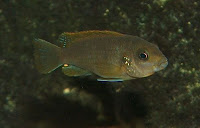 NAME: Hongi Island Labidochromis
NAME: Hongi Island LabidochromisGENUS: Labidochromis
SPECIES: Hongi
ENDEMIC TO: Lake Malawi - AFRICA
MAX SIZE: 15cm
WATER PARAMETERS: 24-28c / ph 7.2 to 8.5
CLASS: Mouth brooding Mbuna
SEXUAL DIMORPHISM: This species of Labidochromis is sexually dimorphic. Males carry a cobalt blue background with vertical black barring down the lateral sides of their body. Males have darker finnage and may contain egg spots in the anal fins. Females are predominantly a brown base with black fins. Diagnosis is most accurate via the vents of the fish at a mature age. Dominant males will possess an even more pronounced orange in their dorsal fin and underlying cheek area.
TEMPERAMENT: Males can be very territorial. Hongis are more similar in temperament to their close relatives in the zebra family (pseudotropheus/metraclima). Other observations to support this statement is the sexual dimorphism in the species and the typical zebra "male" colouration. Aggression in this species is most evident at breeding times where males display and defend their caves vigorously. Along with the labidochromis traits of black finnage, turned down mouth and teeth structure, the overall hostility that this species brings tot eh aquarium and its
 inhabitants is still at a level more commonly recognised with labidochromis - not fatal.
inhabitants is still at a level more commonly recognised with labidochromis - not fatal.DIET REQUIREMENTS: Labidochromis Hongi are herbivorous and their diet in the wild consist of predominantly algae and other vegetation however they also opportunistically feed on insects and small invertebrates. In captivity, they readily take dry foods (sinking pellets/flakes), frozen blood worms/brine shrimp and live foods. It is recommended that you provide your fish with a varied diet by supplementing with frozen or live foods at least once a week to further ensure your fish remain vibrant and healthy. Excessive intake of protein to this family of fish will cause health problems.
AUTHOR'S NOTES:
- Typical mbuna. Most suited to habitat with plenty of caves and crevices.
- L. Hongi is best housed with haplochromides or in a single species tank for breeding purposes. It is strongly advised to keep this species separated from Pseudotropheus sp to prevent interbreeding.
- Selecting juveniles at a size of 5-6cm should allow you to differentiate males and females. Males from the batch will be bigger and more colourful.
- Labidochromis Hongi will breed comfortably in colonies of 1 male and 3 females. The more counterparts in the colony will mean the mouth brooding female has better opportunities to escape constant harassment from dominant males.
- Generally an adult mouth brooding female will hold up to 25 eggs.
- From date of spawning, fry should be free swimming after 14 days depending on water temperature.
- Easy to House and rear. Raise temperatures and feed live foods to optimise breeding.
- Hongis are moderately easy to breed provided it is contained in a healthy environment and dominant males are not in competition with other more larger species in the aquarium.
photos courtesy of mbunamadness.com

No comments:
Post a Comment